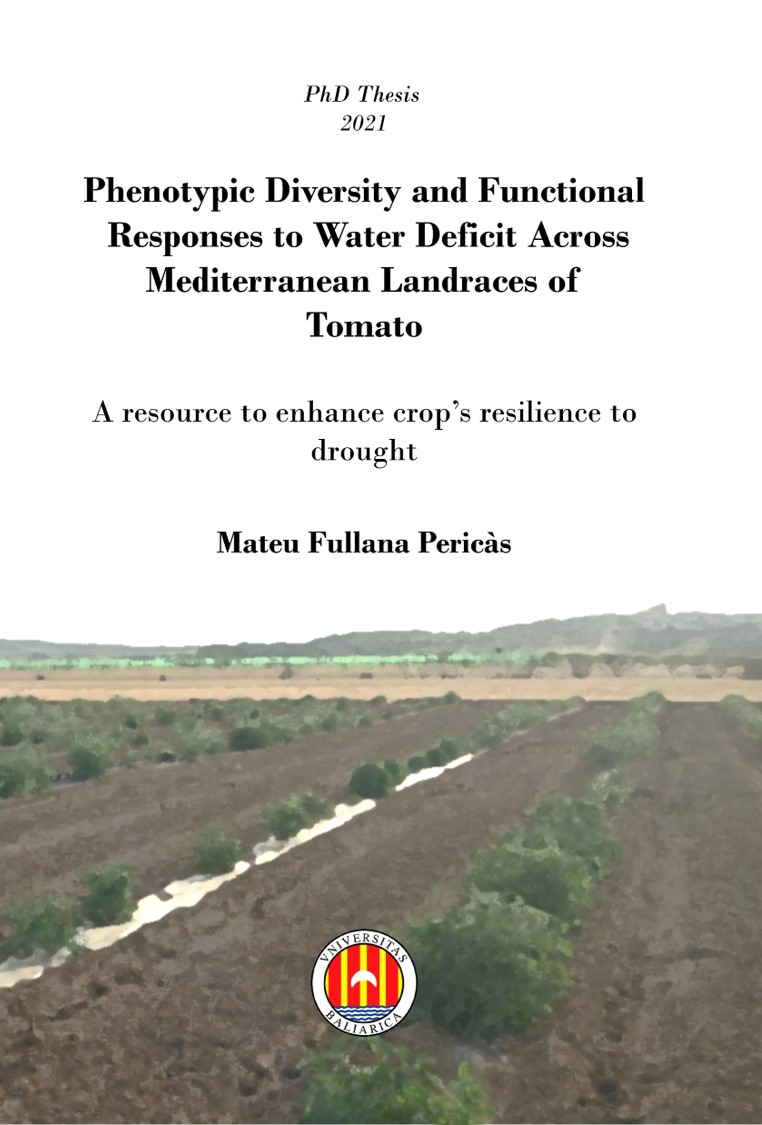Mateu Fullana Pericàs
Title: Phenotypic diversity and functional responses to water deficit across Mediterranean landraces of tomato. A resource to enhance crop’s resilience to drought
Thesis Supervisor: Dr. Jeroni Galmés and Dr. Miquel Àngel Conesa
12/03/2021
Summary:
Tomato (Solanum lycopersicum L.) is the most consumed horticultural crop and with the highest economic impact in the world. Along tomato domestication process and the successive selection and breeding steps, there has been a strong selection for those alleles favouring plant fruit production and fruit weight instead of fruit quality under non-limiting water conditions. However, in the next years most high-yield genotypes may experience a large decrease in their agronomic performance because of climate change effects, which include changes in temperature and precipitations regimes. Hence, it is necessary to prepare tomato crop to face the upcoming scenario, increasing tomato fruit production and quality resilience to extreme weather events as drought periods. In this sense, some Mediterranean genotypes have been traditionally cultivated under water shortage and selected based on their water-use efficiency (WUE) but have been neglected in tomato breeding programs. Similarly, the exploration of alternative techniques to breeding to improve drought resilience, as grafting, have not been largely investigated and the role that those drought-adapted genotypes could play is unknown.
Hence, the general objectives of this Thesis were: (1) to study the physiologic and agronomic variability among Mediterranean tomato landraces and their response to water deficit; and (2) to analyse the response of Mediterranean tomato landraces to grafting in physiologic and agronomic terms.
The results show that in the Mediterranean basin, tomato local selection criteria have been very variable, leading to a wide variation in fruit morphology and quality traits. Under non stress conditions, diverse Mediterranean landraces present clear differences compared to modern cultivars, mostly related to leaf morphology and photosynthetic traits, while no differences have been found regarding fruit production or quality. Results also highlight that better leaf CO2 conductance might be a main factor determining the improvement of net CO2 assimilation rate and WUE. A variable response to water deficit has been found among Mediterranean landraces, with differences depending on their fruit type. Interestingly, some landraces have similar agronomic performance than other high-productive modern genotypes under non-stress conditions, having a lower decrease in fruit production under water deficit. It has been observed that leaf carbon isotope composition (d13C), generally used as a WUE indicator, determine the limit of tomato fruit production under both non and water deficit conditions. High-throughput indicators have been explored to easily phenotype large tomato collections and identify those with an enhanced response to water deficit. Results show that the differences in the leaf physiologic related parameters between tomato drought and non-drought adapted genotypes have been translated to aerial remote sensing measurements, leading to different regression models depending on the observed genotype. Also, this Thesis presents the first attempt to relate tomato fruit quality with different leaf- and plant-level phenotyping measurements in a large and variable tomato collection.
Regarding the use of grafting to improve crops response to drought stress, it has been found that grafting can be a useful technique to ameliorate plant photosynthetic performance under abiotic stress conditions, and that the rootstock selection for a specific environment is determinant for the variations in photosynthesis. The results of this Thesis highlight the potential of grafting to alter several physiologic traits of tomato landraces and their compatibility with the most used commercial rootstocks to improve their agronomic performance. Also, it has been described the potential of drought-adapted tomato landraces to be used as rootstocks in order to increase plant growth and fruit production under both well-watered and water deficit cultivation conditions.

